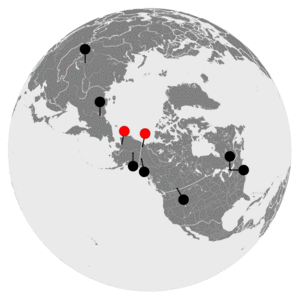Giant pika facts for kids
Quick facts for kids Giant pika |
|
|---|---|
| Scientific classification | |
| Genus: |
Ochotona
|
| Species: |
whartoni
|
 |
|
| Fossil distribution of Ochotona whartoni and Ochotona cf. whartoni. Cape Deceit and Old Crow River are red, other sites black. | |
The giant pika (Ochotona whartoni), also called Wharton's pika, was a mammal that lived a long time ago. It is now extinct, meaning it no longer exists. This animal was part of the pika family, which includes small, furry creatures.
Giant pikas lived during the Pleistocene and early Holocene periods. These are ancient times in Earth's history. They were found in the northern parts of North America, including Alaska in the United States and parts of Canada. Similar pikas have also been found in Siberia, a large region in Russia.
Contents
Where Did Giant Pikas Live?
Scientists have found giant pika fossils in many places. In the United States, they were found in Alaska. In Canada, fossils were discovered in Yukon, Alberta, and Ontario.
A very close relative of the giant pika, called Ochotona cf. whartoni, also lived in eastern Siberia. This shows that these ancient pikas were spread across a wide area.
How They Got to North America
The ancestors of these giant pikas traveled from Eurasia (which is Europe and Asia combined) to North America. They crossed a land bridge called the Bering Land Bridge. This happened during the Early Pleistocene period.
Another group of smaller pikas also crossed this bridge around the same time. This was a different migration than an even older pika species, Ochotona spanglei, which arrived in North America much earlier.
Specific Fossil Finds
Fossils of the giant pika have been found in several key locations.
- In Canada, many fossils were found along the Old Crow River in Yukon. Some of these fossils are very old, dating back millions of years.
- Other Canadian sites include Thistle Creek in Yukon, Eagle Cave in Alberta, and Elba Cave in Ontario. The Elba Cave site is important because it shows the last known time this species lived.
- In the United States, giant pika fossils were first discovered at Cape Deceit in Alaska. More fossils were also found near Fairbanks.
- In Russia, fossils of the close relative Ochotona cf. whartoni were found in eastern Siberia.
What Was the Giant Pika Like?
The giant pika was much bigger than the pikas that live in North America today. It was about the same size as some extinct pikas from China, like O. complicidens. It was also similar in size to a living pika from China called Koslov's pika (O. koslowi).
Modern pikas, like the American pika, often live in rocky areas with lots of loose stones. However, the giant pika preferred different homes. Its habitat was mostly tundra and steppe. Tundra is a cold, treeless plain, and steppe is a large, flat grassland. This habitat was similar to where many pikas in Eurasia live.
When Did They Live and Why Did They Disappear?
Giant pikas lived in North America for a very long time. They were present from about 1.8 million years ago through to about 10,000 years ago. This covers the Lower, Middle, and Late Pleistocene periods.
The last known giant pika lived around 8,670 years ago. This was in the early Holocene period, in a cave in Ontario, Canada. Scientists think it might have survived for a while in rocky areas there. However, like many other large animals from the Ice Age, the giant pika eventually became extinct. The exact reasons for its disappearance are still being studied, but changes in climate and habitat likely played a role.

